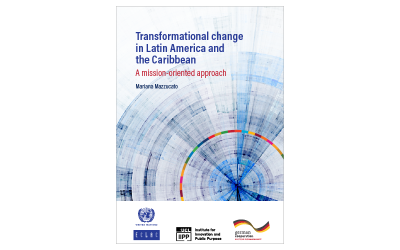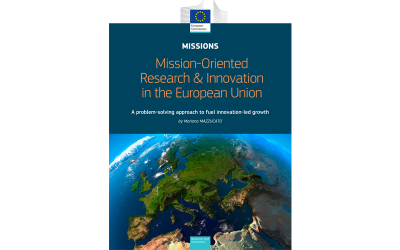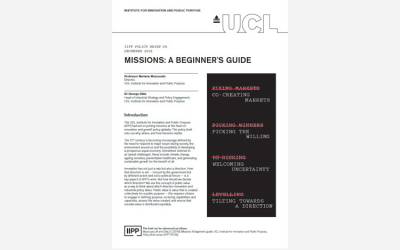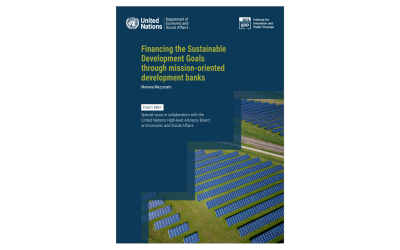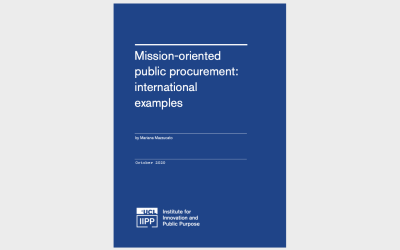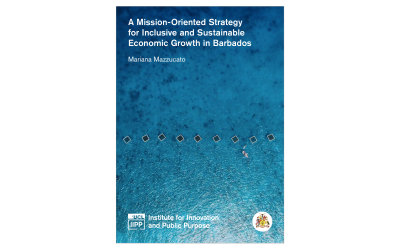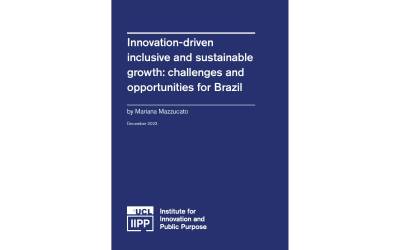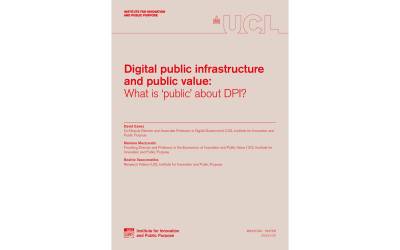The world is facing immense challenges around climate change, health inequities, and digital disruption. The question of our time is how to transform these challenges into opportunities for the public and private sectors to invest, innovate, and collaborate like they have never done before. This economic activity should lead to inclusive and sustainable growth with the rewards being shared equitably between all economic actors.
The UCL Institute for Innovation and Public Purpose (IIPP) advocates for a new 21st-century approach to industrial and innovation policy, one that puts public value creation at the heart of policymaking and emphasises the need for governments to shape and co-create markets, not just fix them. Through well-defined goals, or ‘missions’, policymakers can determine the direction of growth, coordinate action across different ministries and sectors, and shape new markets, industrial landscapes, and national innovation systems.
1. Missions help to direct an economy to achieve cross-sectoral, economy-wide goals.
Mission-oriented industrial and innovation policy offers a new approach to achieving directed economic growth. Instead of focusing on sectors, technologies, or firms (the “old” industrial policy), a mission-oriented approach begins by identifying the most pressing societal challenges that require system-wide transformation before breaking them down into manageable policy pathways. Governments can organize production, distribution, and consumption patterns across various sectors to deliver on these priorities. For example, to tackle the climate crisis, a green industrial policy can help transform every sector in our economy, from mining and energy to transportation and manufacturing. Growth is not the mission, it is the outcome of well-designed mission-oriented policies that catalyse new public and private sector investment and galvanise economy-wide innovation.
2.Missions must follow five key criteria
A. Be bold, inspirational with wide societal relevance: Missions should engage the public. They should make clear that through ambitious, bold action, solutions will be developed that will have an impact on people’s daily lives.
B. Set a clear direction — targeted, measurable, and time-bound: Missions need to be very clearly framed. While enabling long-term investments, they need a specific target that can either be formulated in binary ways (as clearly as whether man has reached the Moon and returned back safely) or quantified (as clearly as whether a certain percentage reduction in carbon emissions against a baseline has been reached across manufacturing).
C. Be ambitious but realistic: Mission objectives should be set in an ambitious manner (taking risks), centred on research and innovation activities across the entire innovation chain, including the feedback effects between basic and applied research.
D. Encourage cross-disciplinary, cross-sectoral, and cross-actor innovation: Missions should be framed in such a way as to spark activity across, and among, multiple scientific disciplines (including social sciences and humanities), across different industrial sectors (e.g. transport, nutrition, health, services), and different types of actors (public, private, third sector, civil society organisations).
E. Involve multiple, bottom-up solutions: Missions should not be achievable by a single development path, or by a single technology. They must be open to being addressed by different types of solutions.
Op-Eds: |
|---|
Op-Ed | There Is No Alternative to Green Industrial Strategy | Project Syndicate | Mariana Mazzucato |
Op-Ed | Industrial strategy demands a new deal with the private sector | Financial Times | Mariana Mazzucato |
Op-Ed | How to Make the Green Economy a Just Economy: Lessons From the U.S. Autoworkers’ Strike | Foreign Affairs | Mariana Mazzucato and Damon Silvers |
3. The governance of missions is crucial. Here are five basic principles:
- Outcomes-oriented policy design: A mission-oriented approach requires a new outcomes-oriented industrial policy framework – one that begins with the challenge, breaks it down into concrete missions, coordinate inter-ministerial and cross-sectoral action, and foster bottom-up solutions.
- Strategic tools and institutions: This means redesigning all tools and institutions in the government’s arsenal to play a role in tackling the mission, including strategic procurement, mission-oriented public development banks, and intellectual property rights.
- New social contract: Missions require a new deal between government, business, and labour – one that recognises all economic actors as value creators and shares the risks and rewards of this contribution using tools such as conditionalities.
- Co-creation and participation: Community engagement and stakeholder relationships play a central role in ensuring industrial policy builds local and regional trust and brings citizens along in the economic transformation.
- Dynamic capabilities: To shift from a market fixing to a market shaping mindset, the public sector and public servants need long-term capacities and dynamic capabilities to foster mission-oriented thinking, risk-taking, and experimentation.
4. Here are the key reports we have written on these five basic principles:
- Public finance: The quality of finance is just as important as the quantity. Public funds and public banks can be powerful tools for directing finance towards tackling big challenges, crowding in private sector finance oriented around missions, and providing the long-term, patient finance that is needed to support innovation through portfolio-based investments. Missions demand capable financial bureaucracies to steer finance towards meeting policy goals and measure the spillovers along the way.
- Procurement: A significant portion of government expenditure resides in procurement budgets, which makes these powerful vehicles for shaping and creating markets. The state’s purchasing power can create market demand for products and services that align with its missions and can incentivize industrial transformation through conditions related to areas such as climate, health, and fair labour practices, alongside existing efforts to involve small businesses and include geographic criteria.
- Capabilities: Missions demand creative, dynamic capabilities within government in order to, for example, anticipate, adapt, and learn within and across organizations; design tools, institutions, and partnerships that are mission-oriented and maximize public value; effectively engage citizens; and build and govern digital infrastructure that serves the common good and supports delivery of all missions.
5. We work with governments globally to help redesign their industrial and innovation policies to be mission driven
- Barbados: Following a visit from the IIPP team to Barbados in February 2023 and several workshops with the Social Partnership –leaders from government, labour and business – the government adopted six missions, relating to climate resilience, social cohesion, food and water security, public health and safety, worker empowerment, and digital inclusion to help direct its growth strategy. The IIPP team is advising on the design of these missions and pursuing an applied learning programme to help in its implementation and governance.
- Brazil: IIPP launched a partnership with the Ministry of Management and Innovation (MGI) and Enap, Brazil’s National School of Public Administration, in July 2023. The team is advising the government on the design and implementation of its new mission-oriented industrial policy, with a focus on designing the state’s public procurement, state-owned enterprises, and digital capabilities to be mission-aligned. In parallel, IIPP is executing an applied learning programme in partnership with Enap to strengthen the country’s public sector capacity.
- British Columbia: In 2021-2022, IIPP advised the government of British Colombia in Canada as it developed its plan to build a sustainable, inclusive and innovative economic plan. Together with the government, IIPP collected input from a wide set of stakeholders, including B.C. businesses, labour organisations, Indigenous communities, not-for-profit organisations and local governments and the public. The work directly influenced the government’s Stronger B.C. Economic Plan, which was launched and adopted in March 2022.
6. Without capabilities nothing will happen. Here is our work on dynamic public sector capabilities:
7. Join our Mission-Oriented Innovation Network (MOIN)
The Mission-Oriented Innovation Network (MOIN) is IIPP's policy network and peer-learning platform which brings together global public sector organisations to share the challenges and opportunities they face when stepping outside the market fixing box into a market-shaping role to respond to bold, difficult and complex ‘grand challenges’ such as climate change, ageing societies and preventative health care.
 Close
Close


